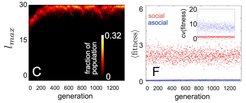Collective Sensing
The capacity for groups to exhibit collective, or swarm, intelligence is often cited as an advantage of group living. However we know little about how grouping may enhance sensing capabilities in animal groups. Previously it has been assumed that social organisms benefit from the pooling of imperfect estimates (e.g. by averaging, or voting) as group size increases. In the context of collective sensing, say of a long-range and noisy environmental cue (e.g. a thermal, olfactory or resource gradient), it was suggested that if each individual makes their own, local, and imperfect, estimate of the direction of the gradient, then by pooling information – via grouping tendency – that sensing capability could be enhanced. This has been termed the “many wrongs hypothesis” specifically, and the “wisdom of crowds” more generally.
The mechanism of collective sensing
We have shown, theoretically, that there is another possibility; that collective intelligence can, in principle, arise from interactions among individuals who do not have, or have highly restricted, capacity to make such personal estimates, as shown in:
Torney, C., Neufeld, Z. & Couzin, I.D. (2009) Context-dependent interaction leads to emergent search behavior in social aggregates. PNAS 106(52), 22055-22060.
In the first experimental test of this idea (Berdahl et al., 2013), using schooling fish as a model system (Figure A, below), we found that individual’s capability to locate dark (preferred) regions increased dramatically as group size increased (Figure B, below). However we were surprised to find that the individual fish themselves were largely incapable of detecting the light gradient, for any group size. So if individual fish cannot detect the environmental gradient, how is it possible that the group can?

As is often the case the real system was behaving in a way that had not previously been considered in the theory of collective behavior. We demonstrated that the gradient detection was an emergent property that demonstrably did not exist at the level of the individual. This distributed sensing was found to require only rudimentary individual cognition and also was extremely robust allowing individuals to respond to environmental gradients that occur over great distances.
If the mechanism we observed in our fish is found to be widespread, as would be suggested by its robust nature and ease of implementation (in evolutionary terms) there may be considerable practical implications. For example it would suggest that we would need to be very careful when managing animal populations as if they are fragmented (such as through over-harvesting, or via habitat modifications) the emergent capability to respond to long-range gradients would collapse resulting, potentially resulting in population collapse.
Berdahl, A., Torney, C.J., Ioannou, C.C., Faria, J. & Couzin, I.D. (2013) Emergent sensing of complex environments by mobile animal groups, Science 339(6119) 574-576.
The evolution of collective sensing
The discovery of emergent sensing has considerable implications for our understanding of the evolution of collective behavior. We took advantage of our detailed studies of the social interaction rules (Katz et al., 2011; Tunstrom et al., 2013) and environmental response behaviors of schooling fish (Berdahl et al., 2013) to develop a biologically-motivated evolutionary model of collective responses to the environment (Hein et al., 2015). We used analytical methods and evolutionary simulations to study how the typed of individual behavioral rules described above produce collective behaviors, and how collective behaviors, in turn, govern the fitness and evolution of selfish individuals. We demonstrated that populations evolve toward a distinctive regime in behavioral phenotype space, where small responses of individuals to local environmental cues cause spontaneous changes in the collective state of groups. These changes resemble phase transitions in physical systems. Through these transitions, individuals evolve the emergent capacity to sense and quickly respond to resource gradients (i.e. individuals perceive gradients via social interactions, rather than sensing gradients directly), and to allocate themselves among distinct, distant resource patches. These results yield new insight into how natural selection, acting on selfish individuals, results in the highly effective collective responses evident in nature.
Hein, A. M., Rosenthal, S.B., Hagstron, G.I., Berdahl, A., Torney, C.J. & Couzin, I.D. (2015) The evolution of distributed sensing and collective computation in animal populations, eLife e10955.




